Dell XPS 13 (Q1 2013) Ultrabook Review: What a Difference 1080p Makes
by Dustin Sklavos on March 21, 2013 5:00 AM ESTSystem Performance
Jarred has been heavily revising our notebook/ultrabook benchmarking suite for 2013, essentially lining up our tests with the convergence between tablets and notebooks and allowing for more direct comparison (as discussed here). This is a good thing moving forward, but unfortunately means that good comparison points between notebooks are presently a bit few and far between. I've included information on the 2012 model where possible, though, so you can see how the generational difference has impacted the XPS 13.
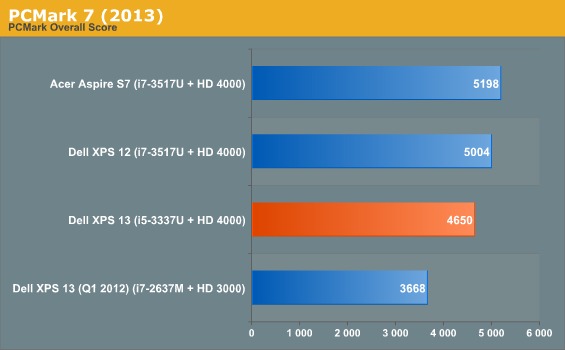
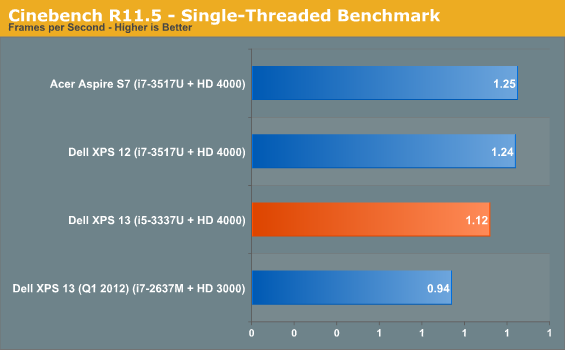
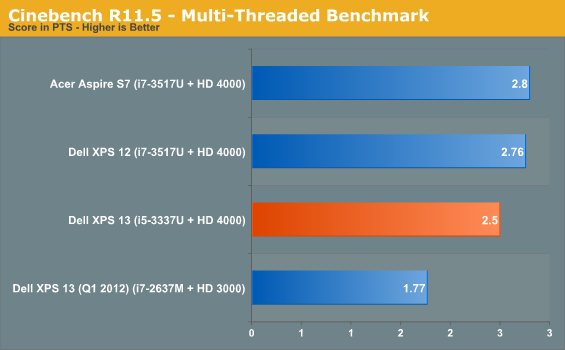
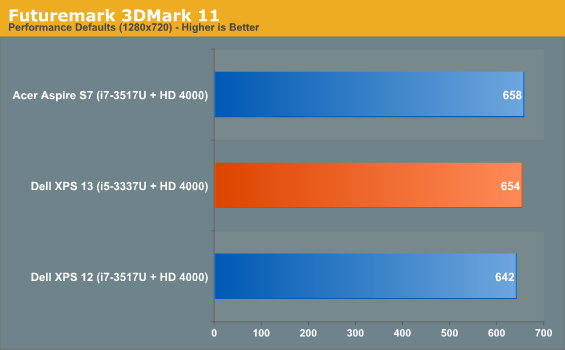
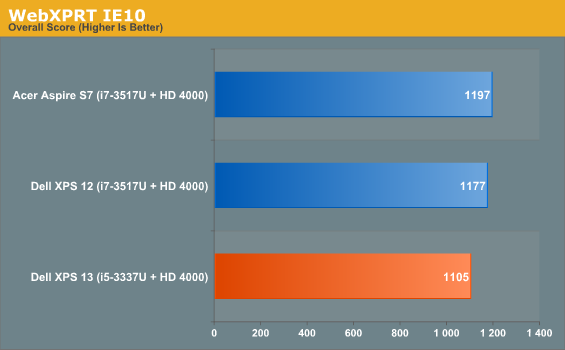
Despite operating at roughly the same clocks, the Ivy Bridge i5-3337U runs absolutely roughshod on last generation's high end i7-2637M. Additionally, the HD 4000 in the i5-3337U is DirectX 11 capable where the HD 3000 was not, allowing us to run 3DMark11.
What's also interesting and helpful is to note the difference between the current high end ULV part, the i7-3517U and the i5-3337U. Or, more accurately, the lack thereof. The XPS 13 can be upgraded to an i7-3537U (another 100MHz clock jump), but as you can see it's an exceedingly incremental improvement and not worth spending money for.










53 Comments
View All Comments
DanNeely - Thursday, March 21, 2013 - link
"t should surprise no one that the RAM is soldered to the board; there's also a black sticker layer that sits between the mSATA SSD and the inside of the bottom panel. It's good to know that you can replace the mSATA drive and wireless card, though, should you need to/desire to."Is there anyone who's more interested in swapping the wifi card than they would have been in upgrading the ram in a few years? The former's something that IMO should have been at the top of the list when looking for ways to shave a few cubic mm.
moep - Thursday, March 21, 2013 - link
Dell is more interested in selling you a new laptop than letting you swap the RAM, so that’s that.baldun - Thursday, March 21, 2013 - link
The problem is not integrating the WiFi card to the motherboard. The problem is with regulatory for each country. If the WiFi card is with antenna connectors, then the regulatory certification is handled by the card vendor, in this case Intel, paying millions of dollars to every country where they want to sell the card. If the WiFi is integrated in the motherboard, then the regulatory will be handled by Dell. Regulatory certification is all about where the antenna connectors are.nportelli - Thursday, March 21, 2013 - link
Agreed. That goes for ANY manufacturer. 8GB ram should be the minimal anymore. Same for 1080p.Silma - Thursday, March 21, 2013 - link
Absolutely. If RAM is soldered then it should be 8GB RAM at the very least.There may be some cons to 1080p in a few situations (touchscreens with items too small to accurately touch) but I'm betting on Microsoft improving Windows pixel scaling soon.
Ideally I would vote for 1200p, which I have had for many years on my Dell Laptops but unfortunately it's out of fashion.
jeffkro - Monday, March 25, 2013 - link
You should be able to increase the size of icons and text without lowering the screen resolution, this is bad design.jeffkro - Monday, March 25, 2013 - link
Nope, lower spec is fine for a low price point. Windows 7 and 8 both run great on 4 gigs of ram, so only people who run ram intensive programs require 8gigs. But yeah if I'm spending over $700 I want core i5, 1080p, and 8 gigs of ram, and I don't care about touch.PS win7 even runs fine on 2 gigs of ram.
GNUminex - Thursday, March 21, 2013 - link
I may just be sheltered from the reality of windows use as a result of using Linux, but I find it hard to see why any one would need more than 8GB of ram when using a current generation ULV processor. I don't see how you could run the sort of work load to eat up 8GB of ram with out being CPU limited first. If you try to just have lots of applications open and idling I guess you could run into ram limitations but is anyone going to do such a thing on a 13" laptop.DanNeely - Thursday, March 21, 2013 - link
Needing >8GB is probably not a common today anymore than >4 was a few years ago; but for power users using a laptop as their primary computer it probably will be in a few more years.With IVBs improved boost levels the gap between ULV and standard mobile/desktop processors has gotten much narrower. On the road thermal throttling will limit sustained peak boost times somewhat; but when it's on a desk an external cooling pad can mitigate the heating.
bkiserx7 - Thursday, March 21, 2013 - link
I do on my 13.3" 3830TG with 2630qm, but I have much more cpu